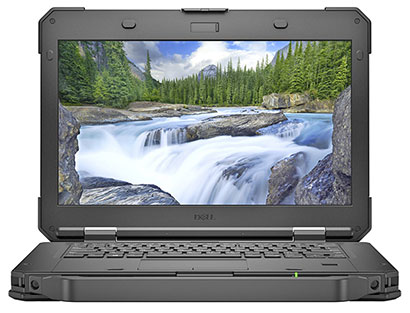|
Dell Latitude 5420 Rugged
Dell's modernized, newly slenderized, full-size, high-performance, semi-rugged laptop under 5 pounds
(by Conrad H. Blickenstorfer)
Share on:




On October 23, 2018, Dell introduced successors for both its semi-rugged and fully rugged 14-inch laptops. The new machines are the Latitude 5420 and 5424 Rugged on the semi-rugged side, and the Latitude 7424 Rugged Extreme on the fully rugged end. On this page we're describing the new Dell Latitude 5420 Rugged.

The Latitude 5420 Rugged is a slenderized version of the Latitude 5424 Rugged that weighs less, too. The 5420 starts at 4.9 pounds and it's almost half an inch thinner than the 5424 (1.3 vs 1.73 inches). To make that possible, Dell had to cut the media bay (so no optical drive) and some other goodies (no second and third drives, no PC Card and ExpressCard slot options). Why? Most likely the competition's semi-ruggeds clock in at five pounds or less. Dell had to match that.
While the Latitude 5420 Rugged is an entirely new design, Dell's approach hasn't changed. The new semi-rugged looks much like the previous one, but it has been changed and improved in numerous ways. The table below shows a comparison of some of the primary characteristics of new and old:
|
Dell Latitude
|
NEW: 5420 Rugged Extreme
|
OLD: 14 Rugged
|
|
Introduced
|
2018
|
2016
|
|
Standard display
|
14.0", 1920 x 1080 (157 ppi)
|
14.0", 1366 x 768 (112 ppi)
|
|
Touch
|
Capacitive
|
Resistive
|
|
Dimensions
|
13.66 x 9.65 x 1.3 inches
|
13.7 x 9.6 x 1.73 inches
|
|
Weight
|
From 4.9 pounds
|
From 6.3 pounds
|
|
Processors
|
Intel 6th/7th/8th gen Core
|
Intel 6th gen Core
|
|
Battery
|
1 or 2 x 51Wh Li-Ion
|
65Wh or 97Wh Li-Ion
|
|
Memory
|
Max 32GB DDR4 2400MHz
|
Max 32GB DDR4 2133MHz
|
|
Max storage
|
2TB PCIe SSD
|
1TB SSD
|
|
Media bay
|
No
|
Yes
|
|
Windows Hello
|
Yes
|
No
|
|
USB Type-C
|
Yes
|
No
|
|
Sealing
|
IP52
|
IP52
|
|
Drop
|
3-foot operating
|
3-foot operating
|
|
Op. temp range
|
-20° to 145°F
|
-20° to 145°F
|
What does all this amount to? The 5420 has the same footprint as the old 14 Rugged. But it weighs almost a pound and a half less and is much thinner, too. That's because of a move to a smaller standard battery, a more weight-saving design, and the above-mentioned ditching of some features. So instead of a fairly large standard battery and an optional extended battery, Dell went to a new design that can accommodate two smaller batteries. That means batteries are now hot-swappable, and the combined battery capacity is actually a bit larger than that of the old extended battery. With dual batteries, Dell says the new design can reach 14 hours of battery life or more.

While the predecessor 14 Rugged was already quite powerful with its choice of Intel 6th generation Core processors, the new machine is more versatile: A 6th gen "Skylake" chip remains available for those who still want Windows 7. A 7th generation Core i3 represents the low end. And very powerful 8th generation i5 and i7 quad-core processors provide significantly more performance than the older model's Skylake chips.
All available CPUs are ultra-low voltage versions with TDPs of just 15 watts and integrated Intel graphics. Discrete AMD Radeon graphics are optionally available.
The specs suggest that all primary storage solid state disk options are of the PCIe NVMe variety. These are much faster than SATA-based SSDs.
Display and connectivity
The Latitude 5420 Rugged has a 14-inch display. Standard resolution is full HD 1920 x 1080 pixel. Full HD was only available as an option on the predecessor 14 Rugged (it came with 1366 x 768 pixel). Dell materials suggest 1,000 nits luminance, but it's not clear if that is for the standard display or only for the optional Direct-View display. Dell also switched from resistive to (glove-capable) capacitive touch on the optional outdoor-viewable screens.
Like the competition in this class, the Latitude 5420 Rugged offers excellent connectivity and expandability. There are three USB 3.0 ports, a USB Type-C port, a native RS232 serial port, a gigabit RJ45 LAN jack, audio in/out, HDMI-out, and a docking connector, all with protective covers. There is a memory card reader. Customers can also get optional VGA, second serial and LAN ports, or a Fischer-type USB port. Below is a look at the left and right sides of the 5420 Rugged, with ports open:

Next is a close-up of the backside of the Latitude 5420 Rugged with the protective door open. Note that the laptop's port covers are not meant to be waterproof, but they securely snap into place, and can easily be replaced should they ever break or wear out.

State-of-the-art wireless communication is crucial in a mobile computing device, be that in the office or out there on the road or in the field. Dell covers that with either Intel or Qualcomm 802.11ac modules that can also include Bluetooth 4.1. Additional options include mobile broadband via a Qualcomm Snapdragon X20 that can handle next-gen Cat16 4G/LTE, and a dedicated u-blox NEO-M8 GPS module. Dell also plans to soon support FirstNet with Band 14 access — a nationwide public safety communications platform — as an available option for Dell's Rugged line.
Semi-rugged design
How tough and rugged is Dell's Latitude 5420 Rugged? It gets a bit confusing here because while the machine is called the Latitude 14 Rugged, it is really a semi-rugged machine. "Semi-rugged" is a rather vague term, something between Dell's standard business laptops and the super-tough Latitude 7424 Rugged Extreme.
As is, the Latitude 5420 Rugged's three feet drop spec means a fall from a desk won't faze it whereas such a mishap can kill a lesser laptop. And while semi-ruggeds generally aren't sealed, the 5420 Rugged does carry an IP52 rating, where the "5" means the device is protected against dust, and the "2" that it's also protected against direct sprays of water at up to 15 degree angles from vertical. So it can handle not only the accidental spill but also a good bit of rain.
An important requirement of semi-ruggeds is that they continue to perform at a high level when it's very hot or very cold. The Latitude 5420 Rugged's operating temperature range is -20° to 145° Fahrenheit. That's very impressive for a machine classified as semi-rugged, and Dell reps say the machine can maintain full performance over the entire range.
Where does Dell stand with the new 5424 Rugged?
As traditional laptops are becoming ever thinner and glitzier, there's an increasing demand — particularly in public service and the enterprise — for something that doesn't scratch or break quite as easily, and does so without the high cost of fully rugged gear. That's where "semi-ruggeds" come in.
While Dell describes itself as "the only tier-1 vendor" with a full line of rugged computing gear, market leader Panasonic, Getac, Durabook and others all offer semi-ruggeds. As of late, there's been a bit of an "arms race" with competitors leap-frogging each other with new features and higher performance. With the new Latitude 5420 Rugged, Dell is again positioned at the leading edge, and this slimmed-down version is as thin and light as the primary competition.
Dell, of course, is also a world-leading provider of commercial PCs, which gives them an edge in large scale production experience and also with enterprises that like to one-stop shop. In addition, there's Dell's Global Command Center that stays on top of well over 100 million supported systems, 17 million annual dispatches and 500+ same day parts centers in over 160 countries, providing 24/7 support in 50+ languages.
Between that, Dell's solid commitment to the rugged space, and the machine's impressive design, up-to-date technology and specs, this new semi-rugged notebook is certain to be a strong competitor.
|




